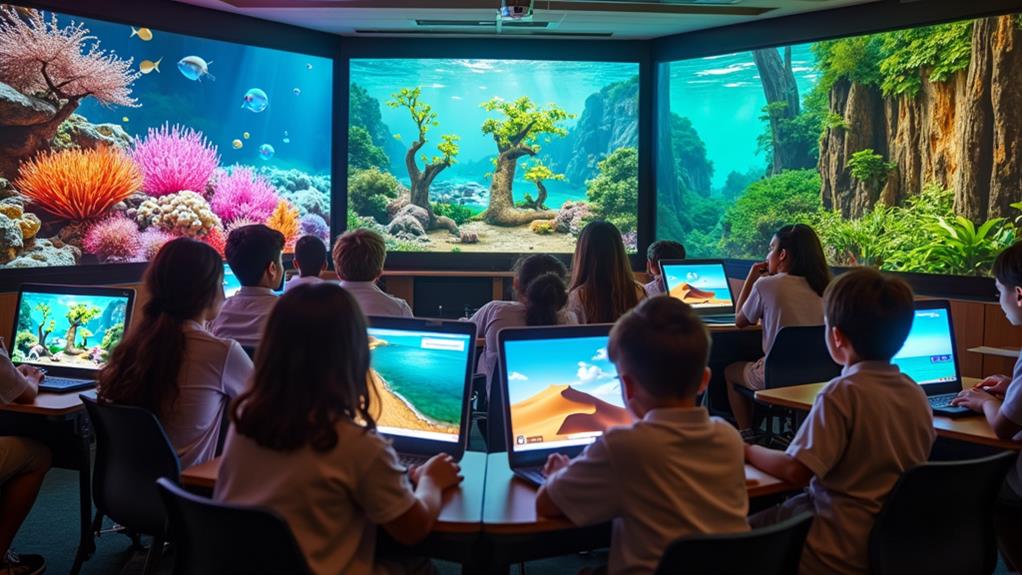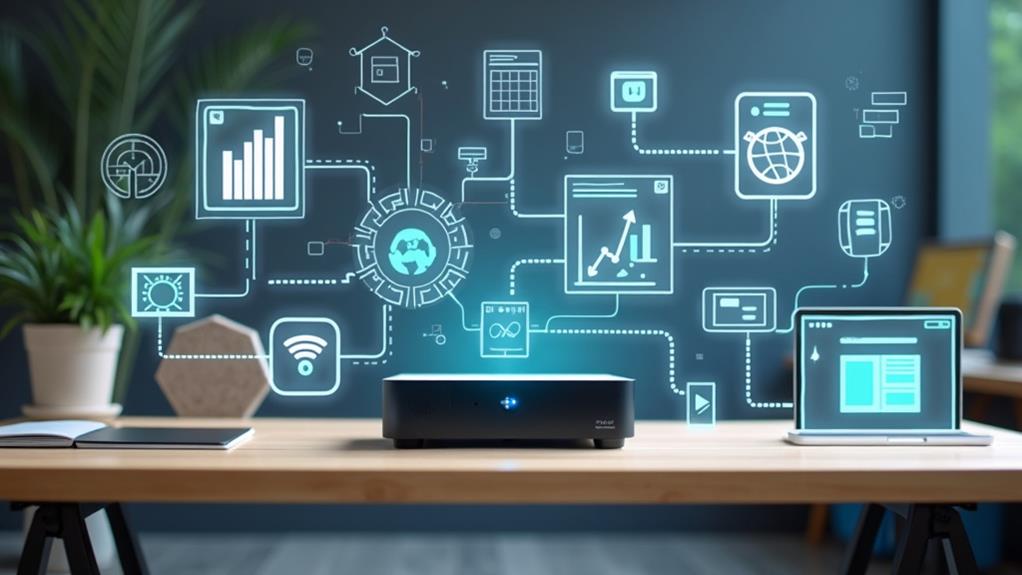



Are you curious about how to connect multiple monitors to a mini PC? Well, worry no more! In this article, we will explore the different ways you can accomplish this task effortlessly. Whether you are a gamer, a stock trader, or simply someone who needs extra screen space, we’ve got you covered. So, grab your mini PC and let’s get started on maximizing your productivity and enhancing your viewing experience!
Connectivity options for mini PCs
When it comes to connecting multiple monitors to a mini PC, there are several options available to suit your needs. Here are some of the most common connectivity options you can consider:
HDMI port
Many mini PCs come equipped with an HDMI port, which is a popular choice for connecting monitors. HDMI (High-Definition Multimedia Interface) offers both high-quality audio and video signals, making it an ideal option for transmitting digital content to your monitors. A single HDMI port can support both video and audio, simplifying the setup process.
DisplayPort
another popular connectivity option for mini PCs is the DisplayPort. DisplayPort technology allows for high-resolution video and audio transmission, offering superior image quality. It also provides additional features like daisy-chaining, allowing you to connect multiple monitors in a series using a single DisplayPort output. DisplayPort is an excellent choice for professional applications that require demanding visual requirements.
VGA port
While not as common in modern mini PCs, VGA (Video Graphics Array) ports are still found on many older models or budget-friendly options. VGA is an analog video interface that supports lower resolutions compared to HDMI or DisplayPort. It is often used for connecting older monitors that still rely on VGA inputs. If you have VGA monitors available, compatibility may be a consideration for your mini PC setup.
USB ports with DisplayLink technology
For mini PCs without dedicated video outputs, USB ports with DisplayLink technology offer an alternative solution. DisplayLink technology allows you to connect monitors using a standard USB port by transmitting audio and video signals over USB. This can be a convenient option if your mini PC has limited video output options or if you want to connect additional monitors beyond the available video ports.
Determining the number of monitors
Before setting up multiple monitors for your mini PC, it is essential to determine the maximum number of monitors the device can support. Here are some steps you can take to determine this:
Check mini PC specifications
Start by checking the specifications of your mini PC. The manufacturer’s website or user manual should provide information on the maximum number of monitors the device can support simultaneously. This will give you a general idea of the limitations to keep in mind during the setup process.
Available video outputs
Next, identify the available video outputs on your mini PC. As mentioned earlier, this may include HDMI, DisplayPort, VGA, or USB ports with DisplayLink technology. Take note of how many of each type of port your mini PC has, as this will determine the number of monitors you can connect using these outputs.
Monitor compatibility
Lastly, consider the compatibility of your monitors with the video outputs available on your mini PC. Make sure your monitors have compatible input ports to connect to the mini PC’s video outputs. Matching the types of ports available on both your mini PC and monitors will ensure a seamless connection and optimal display performance.
Setting up dual monitors
Setting up dual monitors for your mini PC can greatly enhance your productivity and multitasking capabilities. Here is a step-by-step guide on how to set up dual monitors:
Connect the first monitor
Start by connecting the first monitor to your mini PC. Depending on the available video outputs and the input ports of your monitor, you may need to use an appropriate cable or adapter. Connect one end of the cable/adapter to the video output port on your mini PC and the other end to the corresponding input port on the first monitor.
Connect the second monitor
Once the first monitor is connected and functioning correctly, proceed to connect the second monitor. Use the same process as connecting the first monitor, ensuring you have the necessary cables or adapters. Connect one end to the available video output port on your mini PC and the other end to the input port on the second monitor.
Configure display settings
After both monitors are physically connected, it’s time to configure the display settings on your mini PC. This can be done through the operating system’s settings menu. Depending on your computer’s operating system, the steps may vary slightly, but the general process remains the same.
Extend or duplicate display
Choose whether you want to extend or duplicate the display across both monitors. Extending the display allows you to have separate desktops on each monitor, effectively increasing your workspace. Duplicating the display mirrors the same content on both monitors, useful for presentations or sharing content with others.
Set primary monitor
Decide which monitor you want as the primary display. This will be the monitor where your desktop icons, taskbar, and primary applications appear by default. Setting a primary monitor helps ensure consistency and improves navigation between displays.
Using adapters and cables
In some cases, you may need to use adapters or cables to connect your mini PC to your monitors. Here are a few common adapters and cables that can come in handy:
HDMI to VGA adapter
If your mini PC has an HDMI port, but your monitor only supports VGA, an HDMI to VGA adapter can bridge the gap. This type of adapter allows you to connect an HDMI cable from your mini PC to the adapter, which then converts the signal to VGA format for your monitor.
DisplayPort to HDMI cable
Similarly, if your mini PC has a DisplayPort output, but your monitor only supports HDMI, a DisplayPort to HDMI cable can be used. This cable connects the DisplayPort output on your mini PC to the HDMI input on your monitor, providing compatibility between the two.
USB to VGA adapter
As previously mentioned, mini PCs with USB ports can leverage DisplayLink technology to connect additional monitors. USB to VGA adapters enable you to connect a VGA monitor to a USB port on your mini PC, effectively adding another display to your setup.
HDMI splitter
In some cases, you may want to display the same content on multiple monitors. An HDMI splitter allows you to connect one HDMI output from your mini PC and split it into two or more HDMI outputs to connect multiple monitors with identical content.
Configuring multiple monitors on Windows
Windows provides built-in tools to configure multiple monitors. Here is a step-by-step guide on how to configure multiple monitors on a Windows-based mini PC:
Access display settings
Right-click on the desktop and select “Display settings” from the context menu. This will open the display settings menu, where you can configure various aspects of your monitor setup.
Identify and rearrange monitors
In the display settings menu, you will see a diagram representing the connected monitors. Identify each monitor and make sure they are arranged according to their physical placement. You can drag and drop the monitors in the diagram to match their physical positions.
Adjust screen resolution
Click on each monitor in the diagram to adjust its resolution individually. Windows will display a list of resolution options supported by your monitor. Choose the desired resolution for each monitor based on your preference or the capabilities of the monitor.
Set up extended displays
To set up an extended desktop, where each monitor has its independent desktop space, scroll down to the “Multiple displays” section. Select the “Extend these displays” option to enable the extended mode. This will allow you to drag windows and applications between the connected monitors seamlessly.
Additional display settings
Windows also provides additional display settings, such as scaling and orientation. These settings allow you to customize the display appearance and orientation on each monitor. Adjust these settings as needed to optimize your viewing experience.
Configuring multiple monitors on macOS
If you’re using a mini PC running macOS, configuring multiple monitors is also straightforward. Here are the steps to set up multiple monitors on a macOS-based mini PC:
Go to System Preferences
Click on the Apple menu in the top-left corner of the screen and select “System Preferences.” This will open the macOS settings menu, where you can customize various aspects of your computer.
Select Displays
In the System Preferences menu, locate and select the “Displays” icon. This will bring up the display settings menu, allowing you to configure your monitors.
Arrange monitors
In the display settings menu, you will see a diagram representing the connected monitors. Drag and drop the monitors in the diagram to match their physical positions. This ensures that the screen arrangement on your desktop matches the physical arrangement of the monitors.
Adjust resolution and scaling
Click on each monitor in the diagram to adjust its resolution and scaling. macOS will display a list of resolution options supported by your monitor. Choose the desired resolution for each monitor, and adjust the scaling if necessary to ensure content is displayed clearly.
Set up extended desktop
macOS automatically enables the extended desktop mode by default. This means each monitor has its independent desktop space, allowing you to move windows and applications between the connected monitors seamlessly. You can further customize this arrangement by dragging the white menu bar to the desired monitor.
Using third-party software for advanced setups
While the built-in display settings on both Windows and macOS offer adequate configuration options for most users, some advanced setups may require additional features or customization. Third-party software such as DisplayFusion and MultiMonitorTool can provide additional flexibility and functionality.
Tools like DisplayFusion and MultiMonitorTool
DisplayFusion is a powerful tool designed for multi-monitor setups on Windows. It offers features like multi-monitor taskbars, window management shortcuts, and extensive customization options. With DisplayFusion, you can fine-tune your multi-monitor experience and streamline your workflow.
MultiMonitorTool is another popular tool for managing multiple monitors on Windows. It allows you to enable or disable monitors, set the primary monitor, save and load monitor configurations, and more. MultiMonitorTool provides a command-line interface for users who prefer automation and scripting capabilities.
These third-party tools can be particularly useful for power users, professionals, or gamers who require advanced customization options and enhanced productivity features.
Considerations for performance and compatibility
When setting up multiple monitors for your mini PC, it’s essential to consider some performance and compatibility factors. Here are a few key considerations:
Graphics card capabilities
The performance of your mini PC’s graphics card plays a significant role in determining its ability to drive multiple monitors. Higher-end graphics cards typically offer better performance and support for higher resolutions and refresh rates. Check the specifications of your mini PC’s graphics card to ensure it meets your multi-monitor requirements.
Resolution and refresh rate support
Ensure that your mini PC’s graphics card and monitors support the desired resolution and refresh rate. Some older monitors or budget-friendly options may have limitations in terms of maximum supported resolution or refresh rate. Matching the capabilities of your graphics card and monitors will ensure a smooth and seamless multi-monitor experience.
Power requirements
Adding multiple monitors to your mini PC setup will increase its power consumption. Make sure your mini PC’s power supply unit can handle the increased load. If necessary, consider upgrading to a higher-wattage power supply to accommodate the additional monitors.
Operating system compatibility
While most modern operating systems support multi-monitor setups, it’s essential to verify that your mini PC’s operating system is compatible. Ensure that you have the necessary drivers and updates installed to ensure optimal performance and compatibility with your mini PC and monitors.
Troubleshooting common issues
Even with careful setup, you may encounter common issues when connecting multiple monitors to your mini PC. Here are some troubleshooting tips for addressing common problems:
No signal or black screen
If your monitors are not receiving a signal or displaying a black screen, ensure that all cables and adapters are securely connected. Double-check the input selection on your monitors to make sure they are set to the correct input source. Restart your mini PC and monitors, as a simple reboot can often resolve connection issues.
Incorrect resolution or display arrangement
If you notice that the resolution on one or more monitors is incorrect or the display arrangement is not as desired, access the display settings on your operating system and make the necessary adjustments. Verify that the resolution and scaling settings match the capabilities of your monitors.
Flickering or distorted output
Flickering or distorted output can be caused by a variety of factors, including incompatible drivers, loose connections, or outdated firmware. Ensure that you have the latest drivers and firmware installed for both your mini PC’s graphics card and your monitors. Check all cables and adapters for secure connections and replace any faulty components if necessary.
Driver and software updates
Regularly update the drivers and software for your mini PC’s graphics card and operating system. Manufacturers often release updates that address compatibility issues, improve performance, and provide bug fixes. Keeping your drivers and software up to date can help prevent problems and ensure a smooth multi-monitor experience.
Conclusion
Connecting multiple monitors to a mini PC can significantly expand your workspace and productivity. By considering the various connectivity options, determining the number of monitors, and following the setup steps outlined in this article, you can create a multi-monitor setup that suits your needs. Whether you’re a professional who requires the extra screen real estate or a gamer looking for an immersive experience, setting up multiple monitors on your mini PC is easier than ever. Remember to consider compatibility, troubleshoot any issues that may arise, and customize your setup with third-party software if needed. With the right setup, you’ll enjoy the benefits of enhanced multitasking, improved workflow, and a more immersive computing experience.
Disclosure: As an Amazon Associate, I earn from qualifying purchases.






